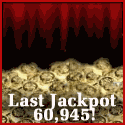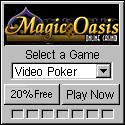Play
To Win
Tips and strategies to help make you a winning casino player Game
Rules
Learn: Blackjack, Baccarat, Craps, Roulette, Slots, Video Poker, Pai Gow Poker
Systems Gallery
Win more, more often with proven betting methods from the systems gallery
Order
Form
A secure on-line order form to purchase products advertised by Let's Talk
Winning.
Playing Online
All about gambling at online casinos. Find out where the best deals are
Best Casino Bonuses -
NEW!
The best collection of on-line casino bonuses,
where you can cash $802 on your sign-up.
Links
and Things
Sign our guestbook, refer a friend, link to other gambling sites.
Gambling News - NEW!
Latest Gambling News - updated daily including
gambling articles, joke of the day and a gambling dictionary.
Newsletter
Click above to read the current edition of our
weekly newsletter. Then get your own free subscription right here. Enter your e-mail
address for immediate delivery of an introductory issue, including a FREE ROULETTE SYSTEM:
Please tell all
your friends about it.
On-Line Forum
Post a gambling question or opinion - get an
answer . . .


 Wanna Win At Slots? Click
Here! Wanna Win At Slots? Click
Here!







It's now $50 bonus every month!








|
==============================================
Thursday, August 22, 2002
The Mathematics of Slot
Machines
Hello everyone,
The casinos are allowed to set the slot machines to give themselves whatever
percentage of profit they desire, without answering to anyone. And the best
part of it, from their viewpoint, is that they don't have to tell the
customers, the people actually playing the machines, just what their
percentage of profit is.
And the profits are enormous. Most of the machines in the bigger casinos are
tied to computers, which give the executives a readout as to profits on each
machine in use. In this way, the casino executives can determine if each
machine is carrying its load. If one machine is showing fewer profits, or is
not profitable at all, then that machine is closed down and examined to see
if it's been tampered with.
Each nickel machine gives the average Strips casino a profit of between
$2,000 and $2,500 a year. If a casino has about 200 of these smaller coin
machines, that's a half-million a year, clear. If most of the machines are
quarter ones, then the profit is going to be approximately five times that
of the nickel machines, or $10,000 to $12,500 a year. Five hundred of these
quarter machines in a big Strip hotel-casino and we're talking between $5
and $7.5 million dollars a year in casino profits on slots alone.
With the slots now taking $1 coins, and with banks of them taking in the
coins as fast as customers can feed the machines, and with the progressive
payouts luring thousands of new customers to slots, the casinos are making a
small fortune with these bigger coin slots. We've just seen what they can do
with quarter machines; with the $1 ones, even with a smaller percentage of
return for the casino per $100 played, the profits are substantial.
What is the usual return to the house on an average slot machine? Well,
that's a hard question to answer, because the figure varies from casino to
casino. All these casinos will tell you, the paying customer, is that their
machines are loose or "millions have been paid out over the years." Or ,
"It's 95% in your favor."
We can grasp the 95% statement, because that means the casino is retaining
5% of all action as profits on its $1 slot machines. As to the other
machines, "loose" has little real significance. What this term, loose, means
to most slot players is that the machines are paying back a substantial part
of the coins played. What percentage, though?
Before we go further into this situation, it would be interesting to see
just how the casino bosses set their machines and figure out their profits
per machine. It's all done mathematically, and the mathematics are fairly
simple and easy to follow.
The average machine usually has three reels. And this same machine usually
has twenty symbols on each reel, the cherries, watermelons, bars, etc. For
our purposes, we'll examine a machine that has three reels and twenty
symbols on each reel.
The first thing we want to know is how many possible combinations can be
made from these three reels and twenty combinations. To do this, we multiply
20 x 20 x 20. By combinations we're referring to every possible one
that can come up before they're all exhausted, such as
cherry-bar-watermelon.
Multiplying this way, we come up with 8,000 possible combinations. Now we
know that the handle must be pulled 8,000 times to get the full cycle of
combinations played out. The casino executives know this also, and base all
their profit percentages on these 8,000 spins.
They have the mechanics set the payoffs so that a certain number of coins
are retained, and the number of coins divided by the 8,000 possible spins to
exhaust the combinations is the profit percentage of the machine.
For example, suppose the machine, after the full cycle is finished, retains
800 coins. Then the house percentage would be 10%. If this same machine had
retained 1,000 coins, then it would go up to 12.5%. If 1,200 coins were
retained, it would stand at 15%, and at 20% if 1,600 coins were retained.
Now that we know this, just what is a loose machine, and, conversely, what
is a tight machine? A loose machine would be one that retains less than 10%
of the coins during any complete cycle. A tight one would hold back about
16% or more of the coins. The average Strip casino will hold back between
16% and 20% on its slot machines. These are extremely tight machines, and
they're made tight because the Strip hotel-casinos cater to high-rollers at
their table games, notably craps, blackjack and baccarat, and the slots are
side profits to them.
In. these casinos, the slots players are either the wives of the men playing
at the table games, or tourists coming through to see the show or to look
around the casinos. These are fair game for the slots in the Strip casinos.
These people aren't catered to; it's the high-rollers who get all the
attention and whatever they want, just so long as they're betting big bucks.
On the other hand, the smaller casinos, those in Downtown Las Vegas and
Reno, cater to the small bettor and the slot machine player. These are the
customers who keep these casinos in business, and they don't want fancy
frills, or opulent settings, and free champagne. They'd prefer a free pizza
and beer and a good return on their slot machine action. And they're given
just that by these smaller casinos.
The machines in these establishments are much looser than those in the fancy
casinos. They're set to payoff a much higher return to the players, and are
fixed so that they retain about 8% of the coins put in. In other
words, the house makes a good profit, but the player will get back twice as
many coins as he would on the Strip.
But in the end, the casino will still retain enough to give it a handsome
profit. In Downtown Las Vegas, for instance, there are no heavy overhead
expenses, just rows and rows of those one-armed bandits, with coins
seemingly falling out of everyone of them in abundance. That's what the
tourists who come in by bus or car from California want. That's what the
"locals," the residents of Las Vegas, want.
In addition, there are other enticements. On the Strip, the casino can't be
bothered with slots players, but downtown, the cocktail waitresses walk by
offering free drinks and sometimes snacks; there are giveaways of money,
prizes and goods. The atmosphere is made comfortable for the slots players.
While the smaller and downtown casinos will have more frequent payoffs and
looser slots, they won't be involved in gigantic six- or seven-figure
payouts at one time. That is left to the bigger Strip casinos. But at the
downtown casinos, there will be plenty of progressive machines paying off in
the thousands, but not in the hundreds of thousands. And sometimes there'll
be grand prizes based on social security numbers or other gimmicks, with a
compact car or RV as first prize.
We discussed the standard three-reel, twenty symbol machine in showing how
the odds are figured, how the casino takes its percentage in profit. But
even if you're playing a four-reel machine with twenty symbols on each reel,
with 160,000 possible combinations, the house will takeout the same
percentage it feels comfortable with. It's as easy to set these monsters as
it is to set the smaller machines.
Despite the setting of
those machines by the casinos, there are ways to make profits out of slot
machines. Consider the two great documents:
47 Ways to Beat the Slots and
Slots - Playing for Playing Money
offered at the
Systems Gallery and take advantage of the
knowledge and experience it took to write them.
Wishing you all the best,
Until next week,
Izak
| WOULD YOU LIKE
TO SUBSCRIBE? |
 |
If you missed any
newsletter, click here for an archive.


|